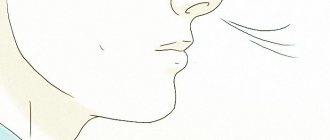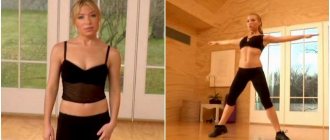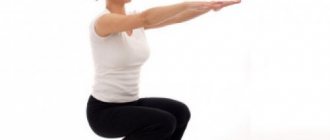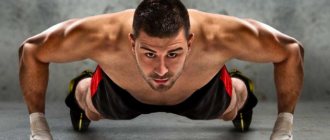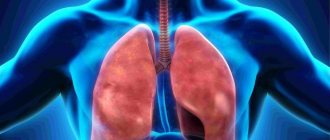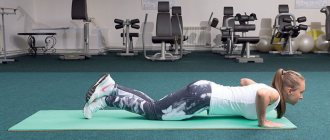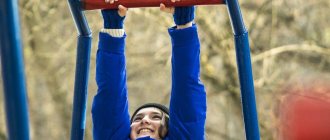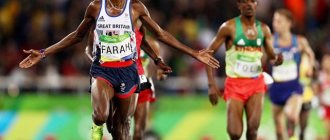How to breathe correctly Correct breathing during exercise
A few days ago, my regular reader asked me to tell her how to breathe correctly.
when doing physical exercise. I really value my readers, so I decided to write an article on this topic. Moreover, many people who come to the gym sooner or later begin to wonder: “Am I breathing correctly? How to? Why am I short of air?
This topic is familiar to me. The problem is that there are different points of view regarding some nuances, for example, breathing during yoga.
I will tell you everything from my experience and my feelings, since I experienced it all myself.
Proper breathing during exercise
It is very important! I'll try to explain it more simply. During physical exercise, our muscles work (contract) and begin to intensively consume oxygen.
If there is not enough oxygen, you will begin to suffocate.
Some may say: “it doesn’t matter how you breathe, the main thing is just to breathe.” This is the same as telling a weightlifter: “just lift the barbell up, and how it is at your discretion” or telling an accountant: “Calculate the money as you want and send the salary at your discretion.”
The correct breathing technique may differ depending on the type of physical activity. I have identified the following types of loads:
- run;
- physical exercise;
- power training;
– yoga and the like.
run
How to breathe properly when running
While running, you need to inhale and exhale through your nose or inhale through your nose and exhale through your mouth. It is necessary.
In this case, it is difficult to describe the correct breathing technique, since there are so many factors that influence the result (for example, running speed and tempo). In general, we can say this: the main thing is to find your own breathing rhythm that suits you. There is an article on the site, so I won’t dwell on it here. By the way, I found some interesting information that might be of interest to you!
physical exercise
How to breathe correctly when exercising
In this case, I will give the following recommendation. The exercises must be performed while exhaling, and when returning to the starting position, inhale. And so on.
You shouldn't hold your breath while doing physical exercise, but there are exceptions. Sometimes the exercise involves holding your breath.
It is advisable to breathe evenly: the length of the inhalation is approximately equal to the length of the exhalation. This type of breathing calms the nervous system and normalizes blood pressure.
power training
How to breathe correctly during strength training
In fact, this point differs little from the previous one. Only the load is more significant and additional heavy equipment (dumbbells, weights, barbells) is often used.
Performing the exercise – exhale;
Return to the starting position – inhale.
But during strength exercises, breathing is more intense; more oxygen is required, without which the muscles will refuse to work. Inhale deeply and exhale depending on the speed of the exercise.
By the way, I myself go to the gym now and do an exercise there in which breathing is done in reverse order. The exercise is as follows:
“Starting position – legs apart, weights in hands. You need to raise your shoulders up"
Raising your shoulders while exhaling is difficult, but when inhaling, on the contrary, it is convenient, since the chest rises and helps lift the load.
yoga
How to breathe correctly when doing yoga
This is probably the most interesting case. Yoga exercises are inextricably linked with breathing techniques. When describing a complex consisting of the nth number of asanas (positions), it is clearly indicated how to breathe correctly
.
As a rule, there is an alternation of inhalations and exhalations. One exercise – inhale, the next exercise – exhale. But sometimes exercises performed while holding the breath are wedged into this chain (unprepared people rarely do it the first time).
By the way, I myself did a little yoga, and I still practice it sometimes. I recommend the Set of Exercises "". I practiced it myself and recommend it to everyone.
Advice!
The article is coming to an end. After reading it, you learned how to breathe correctly
when performing various physical exercises.
Breathing is a very important element of training; you need to pay due attention to it if you want to achieve good results. It is very useful to do gymnastics in the morning, performing special breathing exercises.
I recommend that you familiarize yourself with one popular trend -. Click on the link and study.
See you soon! Happiness to you and a healthy body!
How to breathe correctly during exercise
Breathing during cardio training
After reading about running on the Internet, you inevitably doubt it. “You should take a breath every third step,” says one website. And on the other: “Inhale and exhale in two counts.” Some people claim that light, shallow breathing helps you endure a run, while others say that deep and even breathing helps you endure a run.
“And all because the breathing patterns of runners can be different,” says Alexander Chapaikin, master trainer of the World Class network of fitness clubs. — You shouldn’t imitate someone and try to take a strictly defined step. Sprinters breathe quickly and shallowly. But if you have to walk a kilometer or more, your breathing should be deep and full. Frequently? Slow down and try to keep the speed a little lower than the speed at which this happened.” Place the emphasis on a full exhalation: it will certainly be followed by an equally full inhalation. Professional athletes take several deep breaths before starting (regardless of the distance).
As for other types of cardio exercise, there are, alas, no special techniques that would help you withstand the workout. There is only one piece of advice here. “Breathe in a way that is comfortable for you,” says Ignat Klyatsky, manager of the gym at the Zebra fitness club on Avtozavodskaya. — Are you starting to choke? Most likely, the selected workout turned out to be too difficult for you and will have to be interrupted.”
To determine whether or not you can continue the activity, measure your pulse if possible. The fact that it is close to the maximum (calculated using the formula 220 minus age) is an alarming sign. If you are a young experienced athlete and, although you are breathing heavily, overall you feel good, you can continue training. If you have already passed forty and you have not done fitness for a long time, if you have problems with blood pressure and you experience dizziness, tightness in the chest, nausea - take a break and rest: walk calmly, raising your arms as you inhale and lowering them as you exhale.
How to breathe correctly when exercising
Category Livehacks / October 13, 2016
Correct breathing during physical activity is a whole science. To be honest, it would be worth starting playing sports with a careful study of the rules of correct breathing, and you definitely shouldn’t ignore them.
Now I would like to reveal to you some secrets that will help you significantly expand the effectiveness of your training and finally achieve the desired results: lose weight, gain excellent muscle definition, become stronger and more resilient, in general, highlight what is necessary.
How to breathe correctly during physical activity - simple rules for everyone
Please remember: breathing should be deep and even during training! Get used to it. With shallow breathing, the blood is not properly saturated with oxygen, which, in combination with physical activity, can lead to the most tragic consequences: heart rhythm disturbances, surges in blood pressure, and short-term loss of consciousness.
To prevent all these troubles from happening to you, try to bring the correct breathing technique to automatism. To get started, learn a couple of simple rules:
- breathe not with your chest, but with your stomach (more correctly, your diaphragm); — inhale through your nose, exhale through your mouth (from time to time, nasal breathing is more justified, i.e. inhalation and exhalation are performed through the nose);
— when performing any exercise, exhalation should occur at the phase in which the muscles are most tense. You cannot hold your exhalation for anything!
If you are training in a club, consult with the instructor before starting training and try to take specific advice about breathing throughout the class. Each sport has its own tricks.
As for certain types of physical exercises. There are nuances that I would like to talk about in more detail.
How to breathe correctly while running
Attention!
If you are just starting to run, try to use the breathing techniques of experienced runners. Here it is: two steps on the inhale, two steps on the exhale. Inhalation and exhalation are done smoothly and naturally. Obviously, at first it will be difficult to accustom yourself to a clear breathing rhythm.
Just based on this, start with a slow run or fast walk, without increasing the pace until the breathing technique is brought to automaticity. While jogging, try to breathe only through your nose, and only in certain cases - for example, when running on rough terrain (uphill, etc.).
) it is possible to practice the so-called fire breathing: inhale through the nose, exhale with effort through the mouth.
How to breathe correctly when doing push-ups
Remember the main rule: exhale at the moment of greatest effort. This means that you need to inhale while standing in a lying position, and at the moment of bending your arms, exhale. Raising the body is done while inhaling. Holding your breath during push-ups is prohibited under any circumstances!
It may be unnecessary to remind you that breathing should be deep during push-ups. However, this is true.
How to breathe correctly when doing pull-ups
This, of course, is fundamentally wrong (despite the fact that just such a sequence seems logical at first glance). The secret is that the breath is taken before starting the exercise, and the exhalation and pull-up occur at the same time.
The exhalation phase ends at the top point, and the inhalation is also done there. It is necessary to lower again while exhaling.
When doing pull-ups, you should also not hold your breath - this is simply dangerous and threatens a sharp rise in blood pressure.
How to breathe correctly when doing press
Important!
The most popular mistake when pumping the press is holding your breath for one or two or more lifts. If you breathe intermittently, then the desired result - a toned stomach - will most likely not be achieved. But more than possible:
- deterioration of health, dizziness and loss of consciousness; - feeling of overtraining, extreme fatigue;
- other unpleasant sensations (inconvenience, nausea, muscle pain).
All this, obviously, is associated with a banal oxygen deficiency, and as a consequence, with oxygen starvation of the muscles and brain.
Breathing when performing abdominal exercises should be uniform (without pauses or delays) and fit into the pattern already known to us: inhale in the relaxation phase, exhale in the tension phase (lifting the torso). So, the deepest exhalation is done at the end point of each repetition, which, among other things, helps to work out the abdominal muscles.
Well, now you understand how to breathe correctly during physical activity. All that remains is to apply the knowledge in practice. Good luck!
Other news on the topic:
Technique for chest expansion[edit | edit code]
Of course, promising a significant increase in chest volume only through performing these exercises would mean lying shamelessly. But they can still give something. So. Do 10-15 light squats - they will activate your breathing. Almost immediately after squats, proceed to perform one of the following exercises: dumbbell flyes (information in the simulator) or pullover across the bench. Perform the exercise slowly, inhaling throughout the negative phase of the movement. At the lowest point of the amplitude, hold for 5-10 seconds, then return to the starting position. Repeat 5 7 times. If you have a training partner, you can take a weight that is 25 to 30 times more than you are comfortable with. In this case, you will need the help of a partner when returning the weight to its original position, but the exercise will be more effective.
How to breathe correctly when exercising
Many of you guys may think that everyone knows how to breathe. What's so complicated about that? Inhale - exhale, inhale - exhale. But take your time.
When we breathe, our blood, firstly, is enriched with oxygen, and secondly, unnecessary metabolic products are released from the lungs. And so with every inhalation and exhalation.
During, for example, slow walking, our lungs are ventilated 2.5 times more than at rest; during ordinary, normal walking - 4 times, when riding a bicycle - 6 times, while running - 10 or more times. But if a person participates, say, in a rowing competition, the volume of breathing can even increase 16–18 times.
Increased breathing is closely related to increased blood circulation and activation of all other processes in the body.
Proper breathing is the delivery of a sufficient amount of oxygen to the body, which means the correct functioning of all organs, normal performance and good health.
This is especially important for schoolchildren: after all, they have to sit at a desk or desk for a long time. And everyone needs to remember that you should breathe correctly
What is correct breathing?
When a person is healthy, he breathes through his nose: about 25 percent more air enters the body than when breathing through the mouth. In addition, passing through the nose, the air has time to warm up, become moisturized, and the dust settles on the villi of the nasal mucosa and does not enter the lungs.
By its nature, breathing is a slower process than movement. Breathing has its own pace, its own regularity - rhythm. Therefore, it does not have to be combined with every movement.
If you breathe in a hurry, rushing through the movements, it will be rapid, shallow breathing. It tires the heart with a lot of breathing movements, but does not bring the necessary amount of oxygen to the body. Holding your breath causes shortness of breath and rapid fatigue.
While walking, you should try to inhale every three to four steps, and exhale every five to six steps. Gradually, with each workout, the inhalation should be deepened and the exhalation lengthened.
Attention!
You need to inhale and exhale calmly; when tense, bending, exhale; when relaxing, straightening, inhale. For example, when walking through the forest on skis, when carrying ski poles forward, inhale, when pushing off with poles, exhale. Or: while exercising in the morning, bending down to reach your fingers to the floor, exhale, returning to the starting position, straightening your body, inhale.
Proper breathing is the key to successful training, the key to strengthening the heart, and therefore health.
How to breathe correctly when exercising
Why is it important to breathe properly?
- Deep breathing helps saturate the blood with oxygen and deliver it to the muscles so that they receive more nutrition and contract more efficiently .
- Proper breathing helps control blood pressure so that it does not reach critical levels.
- Good technical breathing also helps stabilize the core by filling the chest with oxygen and allows for better weight control.
- Maximum strength can be developed while exhaling, so your working weight depends on proper breathing.
- Inhaling and exhaling deeply will provide oxygen to the brain and improve mental concentration.
- In some exercises, taking a deep breath helps to better stretch the target muscle group (for example, the pectorals), which ensures its hypertrophy through stretching the fascia - the dense membrane surrounding the muscle.
How to improve the results of physical activity in fitness training
There are special breathing techniques that allow you to maximally saturate the body with oxygen at times when physical activity increases.
For a person involved in sports, it is important, first of all, to develop proper breathing skills, which will not only simplify training, but will also help significantly improve their results. Each sport has its own methodology, however, they all have common features, thesis statement of which as follows:
Each sport has its own methodology, however, they all have common features, the abstract of which is as follows:
- breathing should be deep;
- focus on exhaling;
- maintain a depth of inspiration commensurate with the load.
It is easy to determine the depth of your breathing using a simple test: lie down and place one palm on your chest, the other on your stomach. Take a couple of breaths as usual, paying close attention to your palms. If lying on your stomach rises higher, then you are breathing correctly; Otherwise, you should start mastering belly breathing before you even begin physical activity.
By focusing on your exhalation, you can begin to control the pace and depth of your breathing. After all, the more space in the lungs is freed up when exhaling, the more fresh air can be captured when inhaling. Regardless of the type of sport, breathing that becomes more frequent as a result of physical activity can be regulated using the length and intensity of exhalation. To do this, it is done through the mouth, shortening the path of air outflow, and, accordingly, the time spent on the process itself.
The depth of inspiration must be proportionate to the load in order to ensure a sufficient flow of oxygen and at the same time not lead to its oversaturation. Light and moderate exercise should take place when working up to 40% of the lung volume, with strong physical activity - from 40% to 70%. The approximate tidal volume can be determined by visual observation: exhale fully and then inhale deeply. Approximately how much your chest has enlarged. Under moderate load, it should expand by a third of the observed value, and under heavy load, by two thirds.
Swimming
The most difficult thing is to learn to exhale into the water. At first it is so unpleasant that you start to panic. And instead of vigorously blowing bubbles with your mouth and nose, as the instructor advises, you hold your breath completely. Why suffer so much if you can keep your head above water all the time?
“Firstly, in this case you won’t swim far,” says Yulia Verbina, master of sports in swimming, personal trainer of the Marina Club aquatic programs. — You will start to get tired literally after 20-30 meters. And secondly, such training can be harmful: the muscles of the back and neck will be under constant tension. Master the correct technique and you will be able to breathe deeply and evenly, no matter what style, what distance or how fast you go.”
When swimming, take a short and powerful breath through the mouth: in one count, we completely fill the lungs with air. Exhale for a long time, through the mouth and nose: this helps to get rid of the water that has entered the nostrils. In breaststroke, a breath must be taken on every stroke, in butterfly - perhaps on every second stroke, in front crawl - on the second, third, fifth or seventh, all the time under one hand or alternately under the right and left. And only by floating on your back can you breathe as you like, preferably in the same rhythm and without delay.
Training yourself to breathe properly during exercise can be difficult. Perhaps at first you will be confused and angry that this is only bothering you. But then you will definitely understand that all your efforts were not in vain. When you complete your first kilometer jogging or in the pool without rest.
Breathing of people doing sports
Monday, October 3, 2011 10:00 Post published in the section Physical education and health
Athlete's breathing. Human life is impossible without breathing, without absorbing oxygen from the air and releasing carbon dioxide formed in the body. The work of the respiratory apparatus, like the activity of the heart, occurs continuously throughout a person’s life. Breathing can be weakened or strengthened depending on the needs of the body. At rest, a person inhales and exhales 16-20 times in one minute.
Sports and physical work increase oxygen consumption by working muscles. In this regard, the activity of the respiratory organs increases, the same is observed in blood circulation, metabolism, etc. Playing sports well develops and strengthens the respiratory organs; under their influence, the size of the chest increases, it acquires a beautiful convex shape, and its mobility increases sharply.
In people who do not engage in physical exercise or sports, the difference in chest volume at maximum inhalation and exhalation usually does not exceed 4-6 cm, and in athletes it reaches 8-12 cm or more. Breathing can be deep or shallow, rare or frequent, correct or incorrect. Correct breathing is considered to be rhythmic deep breathing, accompanied by full expansion of the chest. The rhythm of breathing can change for various reasons: from physical effort, under the influence of temperature, during illness. The breathing rate can also be used to judge the effect of physical exercise on the human body.
Increased work of the respiratory organs is expressed in an increase in the frequency and depth of breathing, which significantly increases pulmonary ventilation, i.e., the amount of inhaled and exhaled air increases.
It is known that at rest, pulmonary ventilation in athletes is 6-8 liters per minute, and when performing sports activities (running, skiing, swimming, cycling), pulmonary ventilation increases to 120-130 liters or more per minute.
When an athlete regularly engages in sports, his breathing becomes more perfect, and consequently, oxidative processes, which are so important for all vital functions, improve. Pulmonary ventilation increases, the respiratory rate decreases, which results in savings in the work of the respiratory muscles, which become stronger and more resilient. The mobility of the chest and diaphragm increases.
Better breathing also has a beneficial effect on the blood circulation process.
Regular and properly conducted sports activities develop and improve the functional ability of the respiratory system. Breathing becomes deep, slower, and the vital capacity of the lungs increases.
Terro, especially for the “Site about sports” sportbox.by
Photo: flickr.com; by MikeSchinkel
You can leave a comment.
The importance of proper breathing in fitness
Breathing is a necessary and most important process in the functioning of the human body. It is also one of the few processes that we can consciously and actively control. Breathing correctly is important not only during fitness training, which will be discussed below, but also for maintaining overall health.
The importance of proper breathing:
- improves gas exchange and blood circulation in the body;
- provides comprehensive ventilation of the lungs;
- actively massages the abdominal organs;
- improves concentration;
- calms quickly and effectively;
- helps improve overall well-being;
- helps cleanse blood and lymph;
- enriches the blood with oxygen, which takes part in many vital chemical processes in the body.
Any physical activity, to one degree or another, increases the body’s oxygen consumption, which leads to its deficiency and an urgent need to replenish the losses. Fitness classes involve active muscle contraction, during which the greatest burning of oxygen occurs. With proper breathing, the expended amount of oxygen is continuously replenished, making the workout more effective. Thus, endurance increases and, accordingly, the duration of active cardio training increases; the athlete is able to perform more repetitions of strength exercises and burn more fat. It is thanks to proper breathing that after half an hour of aerobic training the process of active fat burning begins.
During a fitness workout, depending on its intensity, a person makes up to 80 breathing movements per minute compared to the usual 18 in everyday life. The amount of air passed through the lungs can approach 120 l/min compared to 7 l/min with the usual rhythm of movements. These indicators indicate that the breathing process is very important for the body, and especially during stressful physical activity.
